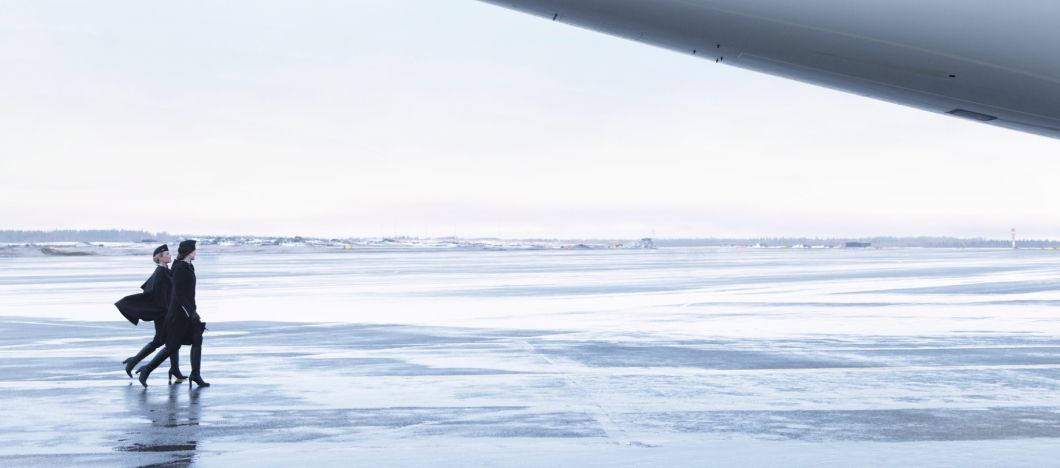Strategy
During the strategy period 2026–2029, Finnair targets profitable growth and invests in ancillary services, retailing capabilities and its loyalty program, with customer needs at the centre.
The strategic focus areas include a choice-based product offering that meets customer needs, engaging with customers also between journeys, a network that meets customer needs, and reliable and efficient operations.
Product offering that meets customer needs
At the heart of Finnair's strategy are core customers who travel with us the most and whose relative share of the company's revenue and profit is large, as well as all customers flying to and from Finland. Focusing on understanding and meeting the needs of these customers in particular supports customer satisfaction and loyalty, and thus the profitability of the business. A product and service offering that meets the needs of core customers also serves the needs of other customer groups well.
Finnair's product offering is modular and offers customers a choice. The company will continue to invest in the development of its digital services and in the personalisation of its offering and customer communications.
Engaging with customers also between journeys
Finnair's goal is to strengthen customer loyalty by being part of their everyday lives also between journeys. The Finnair Plus program has more than two million active members and strengthening the relationship with them offers opportunities for business growth. The company will develop the Finnair Plus frequent flyer program as a business by investing in partnerships and especially in the credit card offering.

A network that meets customer needs
Finnair optimises its comprehensive network according to travel demand. The company's goal is to grow in line with its core market. New destinations and frequencies will be launched according to customer needs, connecting customers to and from Finland, and in doing that, serving also connecting passengers with a broad network. The growth targets take into account the costs of regulation guiding the reduction of carbon dioxide emissions and their estimated impact on flight demand.
During the strategy period, Finnair will also start a gradual renewal of its narrow-body fleet, which will support the achievement of the company's carbon dioxide emission reduction targets. Finnair has set science-based emission reduction targets to reduce its own emissions, and achieving those requires increasing the use of sustainable aviation fuel in particular.
Reliable and efficient operations
Finnair will continue to invest in its strengths, i.e. the reliability and punctuality of flights. During the strategy period, the company will further develop its disruption management capabilities in order to offer our customers a high-quality travel experience even when there are disruptions in traffic.
A culture of continuous improvement plays an essential role in the development of operational efficiency and quality, as does the development of end-to-end processes and the use of AI (artificial intelligence) in everyday work. A strong safety culture remains an intrinsic value for Finnair, which the company will not compromise on under any circumstances.
One Finnair crew responsible for the implementation of the strategy
All Finnair employees play important role in supporting the implementation of the strategy. Guided by the One Crew people plan, the company develops the employee experience and work community at Finnair. The goal is to have one unified team working together for the customer and for Finnair’s future. The focus areas for development are continuous learning and a safe, caring and diverse work community.
Strengthening Finnair's Finnish brand helps the company to differentiate and build customer loyalty. During the strategy period, the company will also invest in the development strategic partnerships, especially cooperation with the airport operator Finavia in Finland, the utilisation of AI as part of everyday work and the development of end-to-end processes. In its sustainability work, Finnair progresses in sync with the industry in advancing initiatives on environmental and social responsibility, as well as governance.
Finnair’s financial targets for the strategy period 2026–2029 are:
Demand (passenger) CAGR 4% during the strategy period
Comparable EBIT margin of 6–8% by the end of 2029
2–2.5 billion euros of investments during the strategy period
Net debt to comparable EBITDA ratio of 1–2 during the strategy period
Cash to sales ratio of at least 20% during the strategy period
One-third of earnings per share, on average, to be paid as dividends or capital returns, considering seasonal economic fluctuations
To support the target of achieving a comparable EBIT margin of 6–8%, Finnair is committed to delivering a profitability improvement of 100 million euros by the end of the strategy period. This ambition is underpinned by a disciplined approach to cost management and strategic initiatives focused on capital-light growth.



